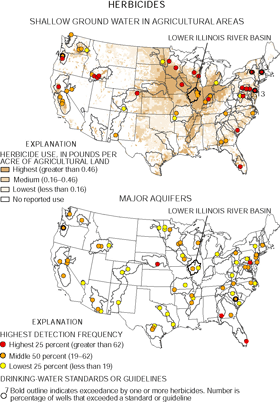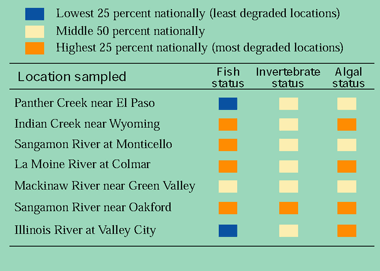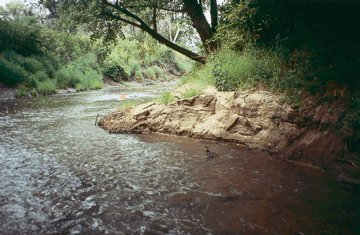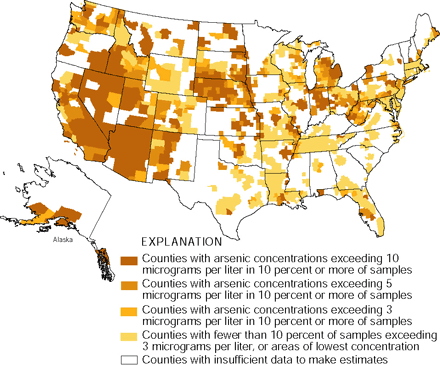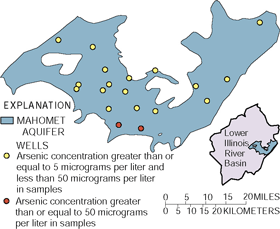MAJOR FINDINGS—Continued
Concentrations of alachlor and cyanazine in the Illinois River decreased
Application rates of cyanazine decreased during the 1996–98 sampling period in anticipation of its use being eliminated in 2003. Alachlor use has declined since the early 1990s—in fact, no use of alachlor was reported for 1998 in the basin. The use of alachlor, by voluntary agreement [21], is decreasing as acetochlor replaces it (fig. 19).
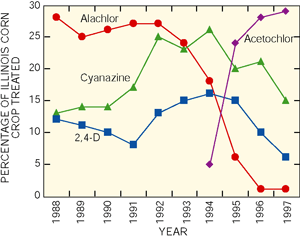 |
| Figure 19. Use of herbicides on corn and soybeans in Illinois changed during 1988–97. Use of three common herbicides has declined from their peak use, but the use of acetochlor has increased substantially. (Data from [22].) |
Cyanazine was detected in 97 percent of the river and stream samples and alachlor was detected in 74 percent of the samples during 1996–98. A comparison of mean monthly concentrations of those detections, however, shows a different story. During 1991–92, samples that were comparable to those collected as part of this NAWQA study were collected from the Illinois River at Valley City. The mean monthly concentrations for the two periods, separated by about 4–5 years or longer, indicate that concentrations of alachlor and cyanazine have substantially decreased (fig. 20).
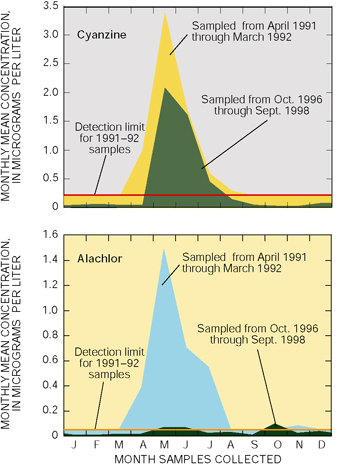 |
| Figure 20. Monthly mean concentrations of cyanazine and alachlor declined substantially in water samples collected from the Illinois River at Valley City. |
Pesticide breakdown products were detected more frequently than the parent compound
In stream and river samples (fig. 21) and ground-water samples (fig. 22), pesticide breakdown products, such as metolachlor ethanesulfonic acid (a breakdown product of metolachlor) and deethylatrazine (a breakdown product of atrazine) were detected more frequently at higher concentrations than their respective parent compounds. The toxicity of most of these breakdown products generally is unknown. Also unknown is the combined effect of parent compounds and the breakdown products. Drinking-water standards or guidelines or aquatic-life guidelines have been established for only a few pesticide breakdown products.
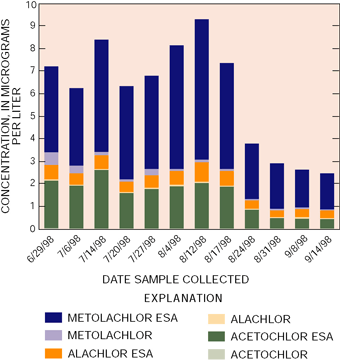 |
| Figure 21. Breakdown products of common herbicides account for most of the analyzed herbicide residue in river water. Long after the parent compound drops below detection, breakdown products can still be detected. Earlier in the spring, acetochlor concentrations peaked at 9 micrograms per liter at this location, Sangamon River at Monticello. (ESA, ethanesulfonic acid) |
Most of the residue of metolachlor detected in ground water consisted of breakdown products (fig. 22). Metolachlor was frequently detected in streams and rivers. Because primarily breakdown products of metolachlor were found in ground water, metolachlor must break down before it can reach ground water.
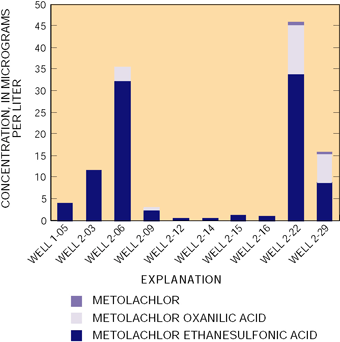 |
| Figure 22. Breakdown products account for most of the residue of metolachlor in ground water. In these 10 shallow wells, metolachlor or its residue was detected. Metolachlor never exceeded the HAL (70 µg/L) in well samples; no drinking-water standards or guidelines have been established for the breakdown products. |
Pesticides were not frequently detected in ground water
Pesticides are much less common in ground water than in streams. Six compounds, all herbicides (atrazine, metolachlor, prometon, bentazon, cyanazine, and dicamba), were detected in monitoring and water-supply wells. No insecticides were detected in ground-water samples. Only four of these pesticides were detected more than once. The maximum number of pesticides detected in a single well sample was four. Concentrations of all pesticides detected were very low (less than 0.44 µg/L). In ground-water samples, no pesticide came close to exceeding an existing drinking-water standard or guideline.
| Standards for water, biota, and sediment quality The USEPA [23–25] is responsible for setting drinking-water standards and guidelines to protect human health. Maximum Contaminant Level (MCL) is the maximum allowable concentration of a contaminant in water delivered to any user of public water systems. MCLs are enforceable standards based on an average annual concentration taken from four quarterly samples of finished drinking water. Health Advisory Level (HAL) is a nonenforceable, risk-based guideline. HALs indicate contaminant exposures below which no short- or long-term human-health effects are expected, based on drinking a specific amount of water for a specific period of time. Risk of illness increases with exposure time and concentration. Of 88 pesticides analyzed for in water, 14 have MCLs and 38 have HALs. Guidelines to protect aquatic life have been set by several agencies including the USEPA, Environment Canada [26, 20], and the International Joint Commission (IJC) [19]. The aquatic-life guidelines developed by USEPA are based on 4-day average concentrations, are intended to protect 95 percent of the aquatic species, and should not be exceeded more than once in 3 years. The Canadian and IJC aquatic-life guidelines, which are more stringent than those of the USEPA, indicate a single maximum concentration that should never be exceeded. Aquatic-life guidelines have been established for only 18 pesticides. Probable Effect Levels (PELs), are used to indicate contaminant concentrations in freshwater sediment associated with adverse effects on aquatic life for the Great Lakes region. The PEL is an estimate of the concentration above which adverse biological effects frequently occur [19, 27]. PELs are established for 18 of the 43 organochlorine and semivolatile organic compounds and 8 of 29 trace elements analyzed for this study. |
Insecticides discontinued in the 1970s were still detected in fish and sediment
Several organochlorine compounds (dieldrin, heptachlor epoxide, chlordane, and DDT) were commonly detected in fish tissue. Fish samples usually comprised 8 specimens of common carp, but at several locations white suckers were collected. These compounds are insecticides or insecticide breakdown products. Most of the organochlorine insecticides are no longer used because their registration was canceled by USEPA in the 1970s. Dieldrin, which was applied to corn and around buildings against termites, is a transformation product of aldrin, another insecticide that was applied to corn before use was discontinued during the early 1970s [28].
Dieldrin was detected in every tissue sample and one-third of the bed-sediment samples collected in the lower Illinois River Basin (table 1). The highest dieldrin concentration in fish tissue in the NAWQA Program across the Nation was detected in fish from the Sangamon River. Every concentration detected in the basin was in the highest 10 percent of the national NAWQA results. Aquatic-life guidelines were exceeded in 30 percent of the samples.
| Table 1. Summary of total chlordane, total DDT, dieldrin, heptachlor epoxide, DDD, DDE, and total PCB concentrations in fish tissue (carp or white suckers) and bed sediment. The detections are compared to guidelines for the protection of fish-eating wildlife. DDD and DDE are breakdown products of DDT [µg/kg, micrograms per kilogram (equivalent to parts per billion); NYSDEC, New York State Department of Environmental Conservation [27]; PEL, Probable Effect Level [26]; –, not applicable] |
|||||
| Fish Tissue |
|||||
|
Compound |
Number of sites |
Minimum |
Maximum |
NYSDEC |
Number of |
| Dieldrin |
20 |
24 |
300 |
120 |
6 |
|
Heptachlor |
13 |
13 |
44 |
200 |
0 |
| Chlordane, total |
20 |
20 |
310 |
500 |
0 |
| DDT, total |
20 |
11 |
550 |
200 |
1 |
| PCBs, total |
15 |
130 |
4,400 |
110 |
15 |
| Bed Sediment |
|||||
|
Compound |
Number of sites |
Minimum |
Maximum |
Canadian |
Number of sites |
| Dieldrin |
7 |
1.4 |
5.5 |
6.7 |
0 |
|
Heptachlor |
0 |
– |
– |
2.7 |
0 |
|
Chlordane, |
2 |
2.6 |
3.4 |
8.9 |
0 |
| DDD |
5 |
1.1 |
4.1 |
8.5 |
0 |
| DDE |
5 |
1.0 |
2.6 |
6.8 |
0 |
| DDT |
0 |
– |
– |
4.8 |
0 |
| PCBs, total |
1 |
57 |
57 |
277 |
0 |
Heptachlor epoxide is a breakdown product of the insecticide heptachlor. The highest heptachlor epoxide concentration in fish tissue in the NAWQA Program nationally was detected in the La Moine River. Heptachlor epoxide was detected throughout the basin but at only one location in the Illinois River. The concentration of heptachlor epoxide in all fish tissue samples from the lower Illinois River Basin in which the compound was detected exceeded the concentration in more than 95 percent of all NAWQA samples. Heptachlor epoxide was not detected in any bed-sediment samples.
Chlordane was found in every tissue sample and in two bed-sediment samples. No concentrations exceeded applicable guidelines. Total chlordane, as defined for this report, is the sum of five individual components of technical chlordane [28]. Among NAWQA studies nationwide, the highest concentration of oxychlordane (a breakdown product of chlordane) in fish tissue was found in fish from the Sangamon River at Monticello.
DDT was once a widely used insecticide in agricultural and urban areas of the United States. Legal use of DDT ended in 1972. Adverse effects of DDT on fish and wildlife include growth impairment, reproductive failure, and inhibition of thyroid activity, and recent studies have shown DDT to be disruptive of reproductive cycles in animals [28].
Breakdown products of DDT were detected in every fish-tissue sample and in almost one-half the bed-sediment samples. The highest total DDT concentrations in the basin in fish tissue and sediment were in samples from Illinois River locations. Concentrations in fish tissue also were high at two Sangamon River locations (in Monticello and downstream from Springfield) compared to national NAWQA data. In bed sediment, excluding Illinois River locations, DDT breakdown products were detected only in a small stream in Decatur.
|
Other organochlorine compounds are persistent in sediments and fish
Polychlorinated biphenyls (PCBs) are a mixture of organochlorine compounds used in industrial processes. Even though production and use of PCBs was banned in the United States in 1979, PCBs commonly are found in fish and sediments because large amounts were produced, they degrade slowly, and they are transported in the atmosphere [28]. PCBs were detected in 75 percent of the fish-tissue samples in the basin, and these detections were geographically widespread. All detections in the basin exceeded the water-quality guidelines for the protection of fish-eating wildlife developed by the New York State Department of Environmental Conservation [27]. The highest PCB concentrations in fish tissue were in samples from Illinois River locations, with concentrations decreasing with increasing downstream distance from Chicago. PCBs were detected at only one location in the bed sediment.
In sufficiently high concentrations, most organochlorine compounds can be toxic to fish and other animals. These compounds bioaccumulate in animal tissue and may result in tumors, hormonal and behavioral problems, immune- and respiratory-system suppression, and abnormal development. Available evidence indicates that concentrations of these compounds have decreased over time and may be leveling off nationally [30, 28].
Common stream animals indicate poor water-quality conditions
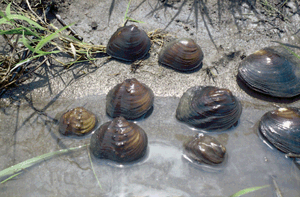 |
| Figure 23. Freshwater mussels are relatively long-lived animals that are indicators of long-term water quality. These mussels were from the North Fork Vermilion River in central Illinois. Mussels bury themselves in the bottom where they filter organic matter from the water. During the twentieth century, freshwater mussel populations declined drastically in the lower Illinois River Basin. (Photograph by David J. Fazio, USGS.) |
Degradation of streams and habitat is caused by more than just chemical contamination. Biological community measures are used to assess water quality because the living components of stream ecosystems reflect the physical, chemical, and biological attributes of a stream. Measures of the algal, benthic-macroinvertebrate (fig. 23), and fish communities in streams each respond to different aspects of water quality over differing time periods and geographic areas.
Algal, benthic macroinvertebrate, and fish indices (table 2) were used to assess water quality as part of the NAWQA Program [32]. The higher the index, the more degraded the stream conditions. (See Appendix.) The algal status index reflects the relative abundance of benthic algal species that are considered tolerant of poor water-quality conditions, including high nutrient concentrations. In some regions, this index correlates with transport and deposition of silt.
| Table 2. Selected biological indicators of water quality—comparison of lower Illinois River Basin sites to national network sites1 |
1 Represents 140 sites in the NAWQA national network that have algal, invertebrate, and fish data. |
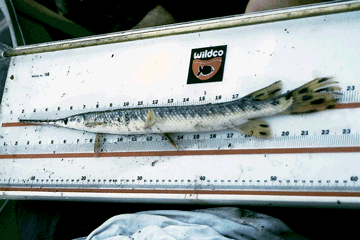 |
| Figure 24. Longnose gar from the Sangamon River in central Illinois. In the basin, the Longnose gar is the most common gar found in small rivers. Many fish were collected, measured, and released to determine the health of the fish communities in the streams and rivers sampled. (Photograph by David J. Fazio, USGS.) |
Eleven community characteristics were used in the invertebrate community status index to assess water quality. The fish status indicator is the sum of scores of four fish-population characteristics (percent tolerant species, percent omnivorous fish, percent non-native fish, and individuals with external anomalies) that increase in concert with water-quality degradation (fig. 24).
In relation to the rest of the Nation, the invertebrate status index in the lower Illinois River Basin was intermediate at all sites except one (table 2). Macroinvertebrate communities of streams in the basin are dominated by many species that are widely distributed, most of which are tolerant of the effects of excess nutrients. Excessive quantities of nutrients in runoff to streams can be harmful to intolerant species by stimulating algal growth that may decrease dissolved-oxygen concentrations at night. The highest proportions of sensitive macroinvertebrate species were in streams with comparatively swift currents because increased water velocity can increase rates of stream aeration and thus maintain higher dissolved-oxygen concentrations (fig. 25).
|
|
| Figure 25. Basin streams with fast current had the most diverse macroinvertebrate communities. (Photograph by David J. Fazio, USGS.) |
Algae index values were either high or intermediate in relation to the entire Nation. The algal status index indicates that general algal conditions (as an indicator of water quality) in the Corn Belt are poor relative to the rest of the country. (See pages 9–10.)
One of the lowest fish-index scores in the country (indicating a healthy fish community) was at Panther Creek near El Paso. This small, shaded stream held a variety of habitats and a diverse fish population. All the biological index scores were high (degraded community) for the Sangamon River near Oakford. Little habitat diversity was found at this site, and concentrations of nutrients were high.
Highest concentrations of polycyclic aromatic hydrocarbons were in bed sediment near urban areas
Polycyclic aromatic hydrocarbons (PAHs) were detected in concentrations at or above a common reporting level of 50 µg/kg in as much as 50 percent of the bed-sediment samples (fig. 26). PAHs are by-products of combustion; sources include fires, manufacturing, power generation, and vehicle emissions. With sufficient exposure, many PAHs are carcinogenic, causing tumors in fish and other animals, and many PAHs are toxic to some organisms [33]. In the basin, the highest PAH concentrations were in the bed sediment of the Illinois River at locations upstream from Peoria. The highest PAH concentrations at other sites in the basin were near urban areas: specifically, in a small stream in the city of Decatur, in the Vermilion River near its confluence with the Illinois River (downstream from Streator and Pontiac), and in the Sangamon River downstream from Springfield. Four detections of PAH compounds exceeded the Canadian interim freshwater sediment-quality guidelines for the protection of aquatic life [26].
![Figure 26. Four polycyclic aromatic hydrocarbons (PAHs) were detected at concentrations that may be detrimental to wildlife that live in bed sediments. Many PAHs are prevalent in sediments of the basin. Shown are percent detections at or above 50 micrograms per kilogram in bed-sediment samples and percent detections that exceed Canadian guidelines for protection of aquatic life [26]. [*, no guideline available; PEL, Probable Effect Level]](images/lirb_fig26.gif) |
| Figure 26. Four polycyclic aromatic hydrocarbons (PAHs) were detected at concentrations that may be detrimental to wildlife that live in bed sediments. Many PAHs are prevalent in sediments of the basin. Shown are percent detections at or above 50 micrograms per kilogram in bed-sediment samples and percent detections that exceed Canadian guidelines for protection of aquatic life [26]. [*, no guideline available; PEL, Probable Effect Level] |
Arsenic exceeded the drinking-water standard in the Mahomet aquifer
The Mahomet aquifer is overlain by more than 100 feet of clay-rich glacial material. Contamination of this aquifer by human activities is minimal [31]. Although arsenic resulting from human activities can contaminate water, high concentrations of arsenic in the Mahomet aquifer are from natural sources. Arsenic concentrations in parts of the Mahomet aquifer exceeded the USEPA current MCL of 50 mg/L. In 1999, the National Academy of Science [34] concluded that this current standard does not sufficiently protect public health. The USEPA has proposed lowering the MCL to 5 mg/L. If the arsenic MCL were lowered to 5 mg/L, then water from more than 60 percent of the wells sampled (18 of 30) would exceed the new level.
Within the lower Illinois River Basin, the percentage of private-well samples with concentrations of arsenic above 50 mg/L was approximately the same as that of samples from public-supply wells. Statewide data from the Illinois Environmental Protection Agency [31], however, indicate the percentage of concentrations above 5 mg/L was different between the public wells and private wells statewide.
Arsenic is a naturally occurring trace element in natural waters. With sufficient exposure, arsenic can cause skin, lung, bladder, liver, and kidney cancer in humans [34, 2]. It also has been reported to impair development and hearing; to adversely affect the vascular, gastrointestinal, and nervous systems; and to be associated with diabetes. The current (2000) arsenic MCL applies to the sum of all arsenic forms in finished drinking water. The USEPA has proposed a new MCL of 5 µg/L. Areas in the Western United States and upper Midwest have relatively high arsenic concentrations in ground water. In Illinois, the dark areas on the map generally indicate the counties overlying the Mahomet aquifer, where water from about 7 percent of wells sampled (2 of 30) exceeded the current MCL (50 µg/L) and 60 percent would exceed the lower MCL.
Only few a concentrations of arsenic above 5 µg/L and none above 50 µg/L in shallow wells (less than 100 feet deep) were found at wells in the western and southern shallow aquifers and other areas in the lower Illinois River Basin. Nationally, water from 1 percent of wells sampled exceeded the current MCL [35], and only 13 percent would exceed the proposed new standard. In Illinois, if they do not treat the water for arsenic, people who draw water from the Mahomet aquifer have greater risk of drinking arsenic in water than ground-water users in the rest of the United States.
|
Radon exceeded the proposed drinking-water standard in almost one-half of shallow wells
The bedrock underlying the glacial materials in the lower Illinois River Basin and especially the glacial material itself contain a high concentration of the source elements that decay into radon. As a result, the potential for high concentrations of radon in ground water and soil gas in the basin is greater than the national average (W.S. Morrow, Jr., U.S. Geological Survey, written commun., 2000).
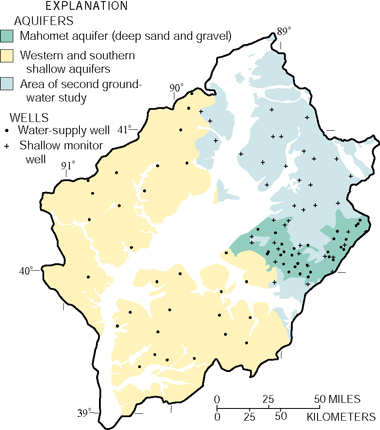 |
| Figure 27. Ground-water studies encompassed most of the area of the lower Illinois River Basin. Two studies of water-supply wells and two studies of shallow, recently recharged ground water were completed. The first set of shallow monitor wells was drilled in the material overlying the Mahomet aquifer. |
Radon was detected in all 30 water samples from the Mahomet aquifer (fig. 27). Concentrations of radon ranged from 110 to 730 picocuries per liter (pCi/L), and the mean concentration was 190 pCi/L. The samples from the Mahomet aquifer, however, had the lowest average radon concentrations of the four groups of study wells. (See pages 25–26.) Concentrations in 7 percent of Mahomet aquifer samples (2 of 30) exceeded the proposed USEPA radon MCL of 300 pCi/L. No sample concentrations exceeded the USEPA-proposed Alternative Maximum Contaminant Level (AMCL) for radon of 4,000 pCi/L. The MCL is proposed for drinking water where there is no other indoor-air radon-mitigation strategy. The AMCL is proposed for drinking water where a multimedia indoor-air mitigation strategy is used to reduce radon exposure.
Radon concentration was higher in samples from the 57 shallow monitoring wells and the 30 water-supply wells in the western and southern shallow aquifers than in the Mahomet aquifer. In the samples from the western and southern shallow aquifers, 55 percent (16 of 29) exceeded the proposed MCL, but none exceeded the proposed higher AMCL. Radon was highest in the samples from shallow monitoring wells in the glacial materials overlying the Mahomet aquifer (fig. 27). In the shallow monitoring wells, 38 percent (22 of 57) of the samples exceeded the radon MCL, although no sample exceeded the AMCL.
| ILLINOIS RIVER: A history of degradation and recovery In Illinois, 7 percent of the fish species have disappeared since about 1900, and many more species are in decline [36]. Smith [37] listed eight conditions responsible for the loss of many fish populations in Illinois streams. Some of these conditions can be found in the basin: siltation; drainage of natural lakes, swamps, and prairie marshes; desiccation during drought; species interactions, including competition from non-native fish; industrial, domestic, and agricultural pollution other than siltation; dams and reservoirs; and increased water temperature.
One of the most notable effects of human activity on stream life occurred between 1900 and 1920 in the Illinois River downstream from Chicago, after the Chicago Sanitary and Shipping Canal opened. The biological repercussions of industrial and domestic wastes being diverted to the Illinois River peaked in about 1920, when plants, benthic organisms, and fish practically were eliminated from the Illinois River downstream from Chicago to a point downstream from Peoria [38]. Since the 1920s, water quality in this reach of the Illinois River has gradually improved because of the improved wastewater-treatment practices upstream. Monitoring by the Illinois Natural History Survey (INHS) has documented partial recovery of fish communities. Between 1957 and 1992, common carp and goldfish dominated fish communities in the main stem of the upper Illinois River. By 1993, however, native species had returned to the main stem, and the relative abundance of common carp and goldfish had declined significantly [39]. In contrast, fish life in the bottomland lakes along the lower Illinois River has not increased to the degree anticipated from improvement in dissolved-oxygen conditions [40, 41]. Compared to urban areas upstream from the basin, streams in predominantly agricultural areas generally have higher biotic integrity and more diverse fish communities that commonly include various intolerant fish species [42, 43, and 37]. |
|||
Volatile organic compounds were detected in ground water at low concentrations
Samples were collected from 60 private and public water-supply wells in the basin to determine the extent of contamination by volatile organic compounds (VOCs); 30 of the wells were in the Mahomet aquifer and the other 30 were in the western and southern shallow aquifers. Detections were similar in samples from wells in the western and southern shallow aquifers (83 percent) and in the Mahomet aquifer (80 percent). One sample from a well in the area of western and southern shallow aquifers contained 0.57 µg/L of methyl tert-butyl ether (MTBE)—well below the HAL for MTBE of 20 µg/L. The concentration of VOCs in almost all of the samples was at or near the method detection limit and was usually 10 to 100 times lower than applicable standards or guidelines for drinking water. The source of these VOCs—especially those in the Mahomet aquifer, which is largely protected from atmospheric or land-use contamination—is uncertain.
Fish and sediment in the Illinois River have high concentrations of trace elements
The Canadian interim freshwater sediment-quality guidelines for the protection of aquatic life [26] were exceeded at four locations for various trace elements. Three of these locations were on the Illinois River close to Chicago. In the Illinois River, bed-sediment concentrations of seven metals (chromium, copper, lead, mercury, nickel, selenium, and zinc) were highest near Ottawa and decreased downstream [44] (fig. 28).
|
|
| Figure 28. Concentrations of three metals in bed sediments decreased in the Illinois River from Ottawa, Ill., to Kingston Mines, Ill. The concentrations of metals were highest near the confluence of the Fox River and the Illinois River at Ottawa. |
In many samples of fish tissue collected in the lower Illinois River Basin, cadmium concentrations were high compared to those in all samples analyzed in the rest of the Nation. (See Appendix.) Concentrations of trace elements were examined in carp liver collected at 17 locations in the basin. The highest cadmium concentration in carp liver from across the Nation (52 milligrams per kilogram dry weight) was detected in the Vermilion River near its confluence with the Illinois River. Concentrations of cadmium in 10 carp-liver samples from the basin were in the upper one-third of the concentrations in all carp-liver samples collected in the Nation. Of those 10 samples, 6 were collected from the Illinois River main stem. Fitzpatrick and others [45] found cadmium at higher than background concentrations in sediment or biota at urban and agricultural locations in the upper Illinois River Basin. Long-term chronic exposure to cadmium can cause kidney and bone damage in humans. Mining and activities related to mining are the main sources of cadmium in the environment from human activities, but other sources include waste incineration, sewage sludge, fertilizers, batteries, tires, and many industrial processes [23].
| Table of Contents || Previous Section || Next Section || Glossary U.S. Geological Survey Circular 1209 Suggested citation:
|



